Matcha Green Tea Powder – The Health Elixir You Can’t Be Without
Matcha green tea powder is one of my personal favourite superfoods. I am hardly ever without my warm cup of matcha green tea. Because of it’s wide array of health benefits – ranging from anti-aging to weight loss – matcha is one of my top recommended superfoods to my clients.

What is Matcha?
Matcha literally means powdered green tea in Japanese. Matcha is made from the highest quality green tea leaves that have been shade-grown to concentrate it’s production of chlorophyll and l-theanine (an amino acid found in green tea that produces a feeling of calm, focused alertness). In fact, matcha has traditionally been used by Japanese Zen monks to aid in their focus and concentration during meditation.
How is Matcha Green Tea Powder produced?
The highest quality, authentic matcha originates from tea plantations around the city of Kyoto in Japan. During the last few weeks before harvest, bamboo mats are placed over the tea plants, essentially shading the leaves from sunlight. As a result of this decreased light, the tea leaves begin to intensify its production of both chlorophyll and amino acids. The bright green colour of matcha is attributed to the high concentration of chlorophyll whereas the calming effect comes from increasedamounts of l-theanine.
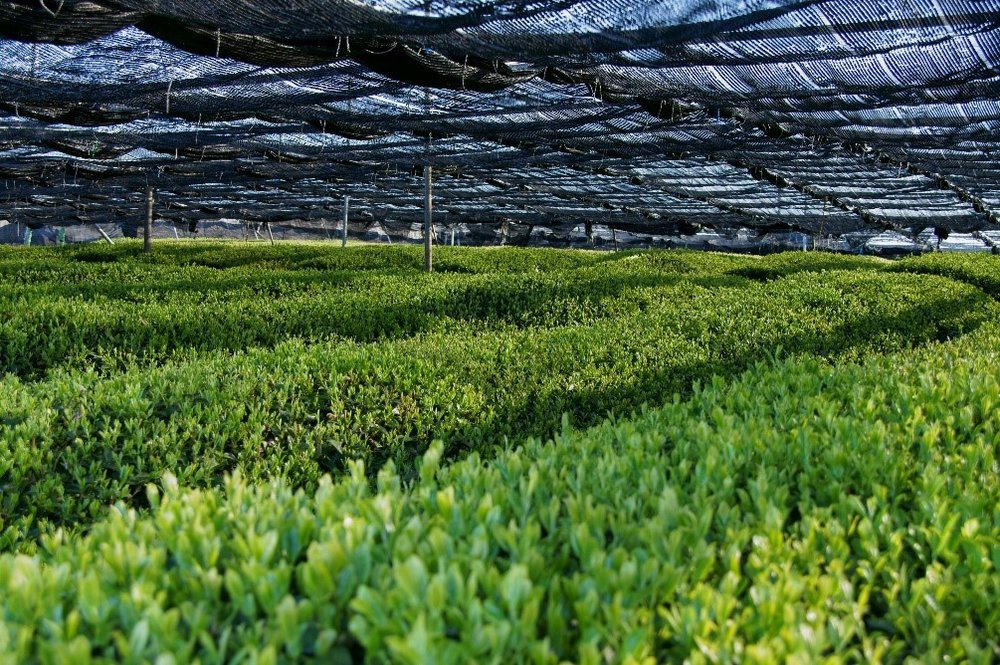 Matcha tea plants are shaded with a canopy during the last weeks before harvest.
Matcha tea plants are shaded with a canopy during the last weeks before harvest. 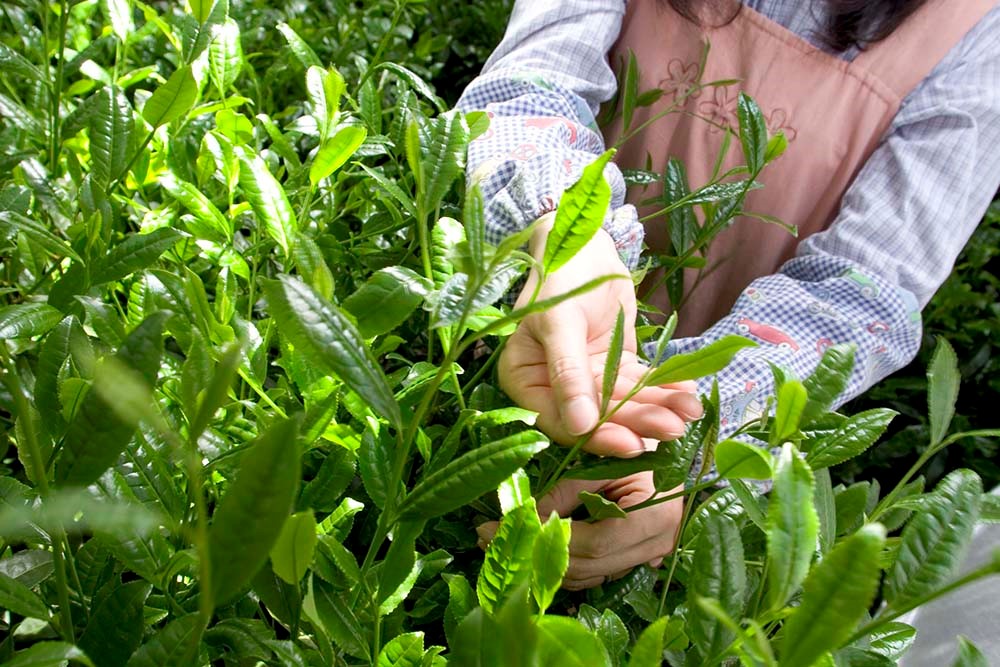 Matcha production only uses the youngest, most tender top leaves which are meticulously picked by hand.
Matcha production only uses the youngest, most tender top leaves which are meticulously picked by hand.
Only the youngest, most tender top leaves (with the most anti-oxidants) are picked by hand for matcha production. Once picked, they are steamed to preserve colour and nutrients, and then dried. Then the delicate and time-consuming task of destemming and deveining happens. This process is all done by hand, resulting in the highest quality green tea leaves known as Tencha. The last stage of matcha production involves the grinding of tencha with large granite wheels that rotate very slowly and gently, to ensure no heat or friction is produced that can damage the nutrients inmatcha.
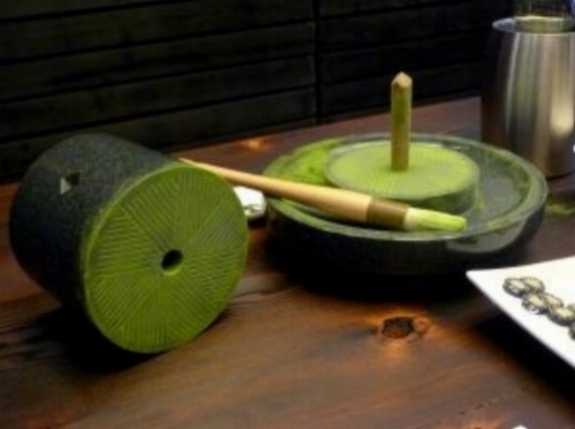 Traditional granite wheel used for hand-grinding matcha leaves into a fine powder
Traditional granite wheel used for hand-grinding matcha leaves into a fine powder
What are the health benefits of Matcha?
Matcha has been a time-honoured health elixir in Japan for centuries, with many health benefits which have been researched extensively. Many of matcha’s health benefits can be attributed to its exceptionally high concentrations of antioxidants, specifically the catechin EGCG.
Matcha only uses the youngest and most tender shade-grown top leaves which are much higher in L-theanine and nutrients than the sun-grown, older and more robust bottom leaves (found in green tea used for infusion or low-grade tea powder).
Unlike other teas, where you drink an infusion and discard the leaves, matcha is the only form of tea in which the leaf is consumed in its entirety, giving you 100% of the nutrients it has to offer.
Healthy Heart and Diabetes
The powerful antioxidants known as EGCGs in matcha green tea have been shown to aid in reducing the levels of triglycerides, total cholesterol and hepatic glucose content in individuals with diabetes. People who drink matcha on a regular basishave lower LDL (bad) cholesterol while at the same time displaying higher HDL (good) cholesterol levels. Matcha green tea may prove valuable for maintaining heart health and good blood sugar levels
Weight Loss and Metabolism
Thanks to Matcha green tea’s high levels of catechins, especially EGCG, it is among one of nature’s best aids for weight loss and metabolism support. Matcha’s catechins has thermogenic properties and promotes fat oxidation. A study found that consuming matcha green tea can increase thermogenesis (the body’s unique rate of burning calories) from a typical 8 to 10 percent of daily energy expenditure to between 35 and 43 percent of daily energy expenditure. Another study demonstrates that exercising immediately after drinking matcha green tea results in 25 percent more fat burning during exercise.
Anxiety, Insomnia and Concentration
L-theanine, found in high concentrations in Matcha green tea, promotes a calm relaxed alertness without causing drowsiness. L-theanine rapidly enters the body when ingested (within roughly 30-40 minutes) and relaxes the brain, calms racing thoughts promoting concentration. Equally beneficial for treating anxiety, insomnia or for improving concentration.
Detoxification
The high concentration of chlorophyll, is evident in matcha’s bright green colour. Chlorophyll is an excellent cleanser to detoxify cells in the body. It aids in maintaining the alkalinity of the blood and tissues. It cleanses and flushes the colon of waste materials. Matcha naturally removes heavy metalsand chemical toxinsfrom the body through the specific nutrients it contains.
How To Prepare Matcha Green Tea Powder
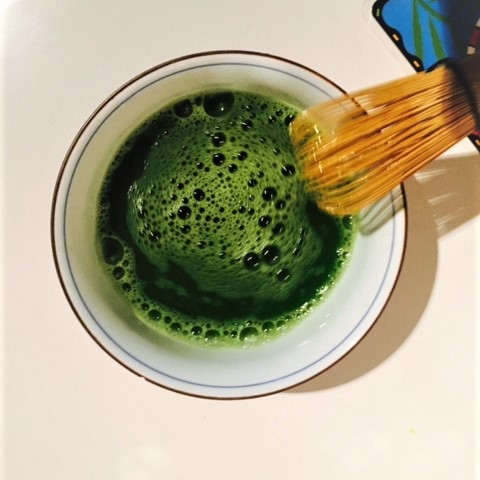 Traditionally Matcha is whisked in a bowl with hot water and a bamboo whisk.
Traditionally Matcha is whisked in a bowl with hot water and a bamboo whisk.
Traditional Recipe
Preparation using a bamboo whisk: Sift ½ to 1 tsp. ofmatcha powderinto a bowl. Add 4 oz hot, not boiling, water (about 180 degrees). Whisk vigorously in a zigzag motion until a light foam covers the tea. Add more hot water if desired. Matcha is ready to drink. Adjust proportions to taste.
Or if you don’t have a bamboo whisk………
Preparation with a spoon: Mix ½ tsp. to 1 tsp. of matcha powder with 1 oz. of hot ( not boiling water) in a wide-bottomed mug or matcha bowl, stir with spoon to make a paste, then add hot water to desired taste and whisk until frothy.
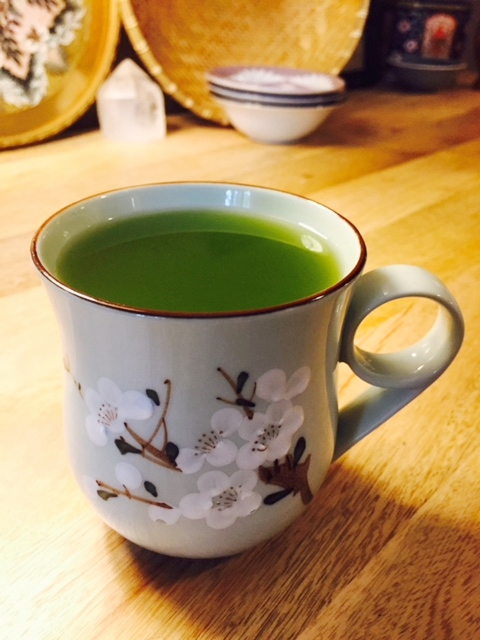 In Japan, matcha tea is served in a bowl, just as in France café au lait is also served in a bowl. Here I drink my matcha tea out of a pretty cup.
In Japan, matcha tea is served in a bowl, just as in France café au lait is also served in a bowl. Here I drink my matcha tea out of a pretty cup.
Variation Recipes
If preferred, add sweetener to the above Traditional Recipe. Natural sweeteners such a stevia, xylitol, Lankanto (monkfruit sweetener) or coconut palm sugar is healthier than white sugar or artificial sweeteners like Splenda.
Enhance the health benefits of your blender smoothie by adding ½ to 1 tsp of Matcha Green Tea powder.
Matcha Green Tea Latte Recipe – smooth and mellow with a natural sweetness from the warmed milk.
Ingredients:
1 cup water
1 to 2 tsp (5 to 10 mL) matcha powder
1 cup (250 mL) heated whole milk or your favourite milk alternative
Honey or other natural sweetener to taste
Directions:
Mix ½ tsp. of matcha powder with 1 oz. of hot, not boiling water in a wide-bottomed mug or matcha bowl, stir with spoon or whisk to make a paste. Slowly add heated or frothed hot milk and stir. Add sweetener to taste.
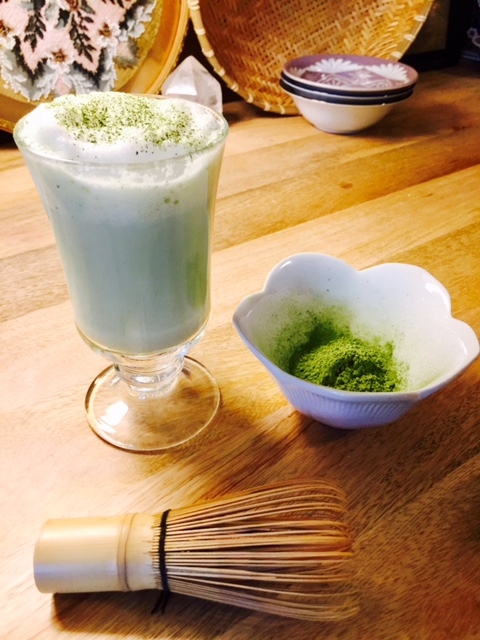 Silky Smooth Matcha Green Tea Latte
Silky Smooth Matcha Green Tea Latte
